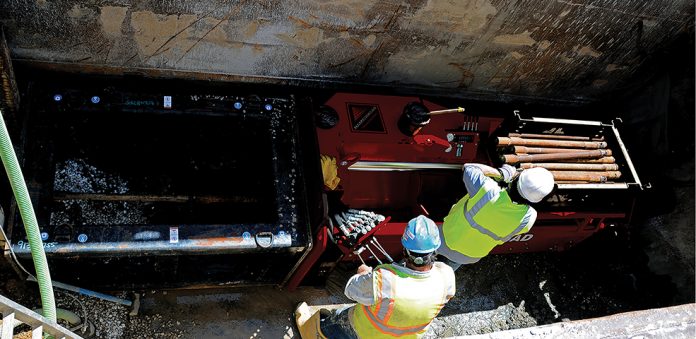There is no doubt that there are many contractors well-versed in the pipe bursting technique. Even so, Mark Maxwell, Trenchless Application Specialist at HammerHead Trenchless, said that he still sometimes runs across a contractor in trouble that could have been prevented.
Maxwell has been an operator, technician and consultant in the pipe bursting method and its equipment almost as long as it has been available in the U.S. During that time, he has noted several keys to successful pipe bursting job completion.
Prior preparation
Maxwell’s first contractor tip is “Do your homework.” He said: “Know everything you can about a job before you begin. Get access to soil sampling results. Know any work that’s been done on the line. Even check what the temperature’s going to be.” Preparation should include knowing product specifications and manufacturer recommendations. If the equipment manufacturer offers project consultation, make use of it.
Maxwell said one obvious consideration is to have equipment properly sized to the job. If contractors don’t own equipment matched to the job, they should rent it or consider buying it, expanding their capabilities for future jobs.
Be prepared to alter pit size. “The industry rule of thumb is 3 to 1,” Maxwell said. “A pipe 3 meters down would need at least a 9-meter-long entry pit.” However, pit length often needs to be longer. The pipe’s wall thickness, the manufacturer’s own recommendations, and even ambient temperature must be factored in since cold pipe cannot bend as easily. One pipe manufacturer, Maxwell said, recommends a 12-to-1 ratio for the pit for one of its products. “Sure, contractors could try to use their bucket to push the pipe down, but why struggle with it? Plus, you’re marring up brand new pipe before you even put it in the ground.”
Soil conditions determine length
of run
Runs of 300 meters or more have been completed in a single pull. Contractors and even their customers may have overambitious expectations due to these successes. Maxwell warned: “Soil conditions determine length of pull. Always. You can’t see the soil the pipe is lying in. Start small.”
Even with soil samples in advance, Maxwell suggested contractors start with 100 meters. “At the end of that run, if you’re still pulling at 7.5 tonnes, you don’t want to increase the length. We did a 275-meter pull recently on an extensive pipe replacement job, but only after we started with a 100-meter, then increased to 150 and 230. We knew then we could attempt 275 meters.”
Soil conditions also determine lubrication requirements. Clay soils typically require polymers. For sandy soils, the contractor can use bentonite. “Upsizing pipe almost always requires lubrication to get the pipe in place before returning, displaced soil seizes it.”
Pneumatic vs static technique
When soil conditions are wet, Maxwell cautions not to use the pneumatic pipe bursting method. “Think of it in terms of working with cement. Cement contractors vibrate concrete to increase its density and strength. Pneumatic bursting tools can make wet soil conditions so difficult, it can stop progress midway through.”
Static pulling method in difficult soil raises its own concerns. “When a pull gets too tough for your pneumatic tool, it simply stops progressing,” Maxwell said. “But static pullers will just continue pulling. It’ll tear the pipe apart. Watch your gauges.”
Giving longer runs a rest
Pushing to beat a deadline might tempt contractors to make reconnections prematurely. “Longer runs stretch pipe as it’s pulled in,” Maxwell said. “You may have quit pulling, but the pipe continues moving.” Reconnecting laterals before the pipe contracts completely can result in connection failures. Some longer projects might require waiting overnight before connecting laterals.
Training
Although workers should be trained for any task they are assigned to do, Maxwell said working with fusible pipe is especially critical. An inexperienced fusion welder’s joint might look good enough at the surface but come apart later in the ground. “Doing two supervised fusion welds is not sufficient training. Get your fusion welders trained.”
Safety, maintenance
Maxwell’s final advice deals with routine worksite safety measures and machine care. Contractors should ensure they properly shore the pits, set cribbing and brace the wall. Hydraulic hoses should be inspected and kept from damage during transport and as the machine is raised and lowered in the pit. “Learn and follow safety requirements and observe your equipment manufacturer’s recommended maintenance routine.”
No one can completely avoid unexpected surprises on a given job, but Maxwell said these common- sense tips ensure pipe bursting contractors of their greatest chances for successful runs
www.hhtrenchless.com




